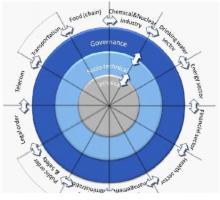Challenge
Cybersecurity is about protecting cyberspace from malicious attacks. As shown in Figure 1 (Van den Berg J. et al., 2014), the cyberspace consists of layers and sub-domains. On the top of the basic technology layer (based on the TCP/IP protocol suite) resides the socio-technical layer enabling a myriad of cyber activities exercised by billions of people in all countries of the world. The governance layer, showing how both of these layers are governed, is complex and involves a huge variety of human actors and organizations residing in different sub- domains. Securing cyberspace has been a long time lagging behind its constant growth in size and complexity. Research shows this gap can be reduced by increased collaboration, knowledge exchange, and by using the Community of Practice (CoP) concept deemed as an appropriate tool to manage knowledge (Duin, L. B. G. R., 2020). The concept refers to a group of individuals who have an interest or a passion about the topic, and who deepen their knowledge and expertise in the area by interacting one with another.
Cybersecurity education prepares future professionals with the knowledge and skills needed to cope with the risks and threats emerging in the cyberspace. Consequently, the collaboration is necessary to acquire new knowledge and to incorporate it into the curriculum. For instance, at this very moment, the cybersecurity graduates are not well prepared to cope with protecting the national critical infrastructures, including industrial control systems. As the number of topics added to the area increases, so does the variety of the academic backgrounds of the students interested in the university programs. Hence, delivering formal cybersecurity education to future professionals is a significant challenge for educators.
The previous cooperation among institutions in the Baltic countries, in particular the ones from the EU’s eastern partnership, Was mostly based on bilateral contacts and short-term projects. Hence, establishing the community of practice among professionals and educators is needed to increase the level of internationalization, enable innovative and societally responsive state-of-the-art cybersecurity education along with the conditions for a sustainable presence.
References:
Duin, L. B. G. R. „Collaboration could improve cyber resilience: A Community of Practice approach in the Rotterdam port area. „2020.
Van den Berg, J, et al. „On (the emergence of) cybersecurity science and its challenges for cybersecurity education. „Proc. NATO STO/IST-122 symposium. 2014.





